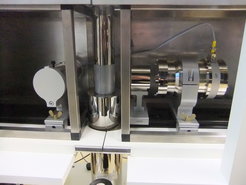The application of Mössbauer spectroscopy in solid state and materials research takes advantage of the hyperfine interactions, i.e. the interactions between the electronic shell and the nuclear charge distribution which are sensitive to the chemical environment. The most important parameters extracted from the spectra are the isomer shift IS, the quadrupole splitting QS, and the magnetic hyperfine field Bhf. Mössbauer spectroscopy is a local probe which supplements the information from scattering techniques and yields information on oxidation states and chemical bonding, coordination environments, magnetic ordering phenomena, and dynamical effects.
At present one Mössbauer measuring station for 57Fe Mössbauer spectroscopy is available which consists of a WissEl Mössbauer spectrometer, a 57Co/Rh source, and a Janis closed cycle refrigerator (CCR) cryostat (SHI-850-5) for experiments between 5 and 300 K.
Several materials of contemporary interest in solid state and materials science are studied, for instance iron-based pnictide and chalcogenide superconductors as well as related Mott insulating compounds, magnetic Heusler alloys, and transition metal oxides.

